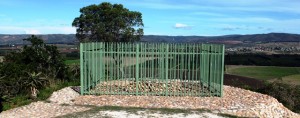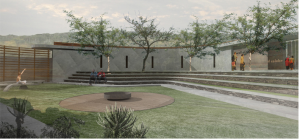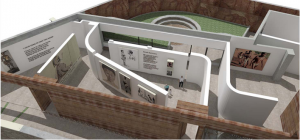In 2009, the South African Department of Arts and Culture announced a competition to design a Sarah Bartmann Centre of Remembrance. As the Department of Arts and Culture announced, the aim of the center is, “ to honour and document the life of Sarah Bartmann as well as the heritage of the Khoi and San people” (dac.gov.za).(1) The center would be built adjacent to her grave site, as a way to aid in the development of the local economy of the Kouga municipality in which the grave resides (gov.za).

The description of the center that was announced during the opening of the design competition outlined three ‘doctrines’ that the design should be based around: memory, healing, and hope.(2) The Khoi Khoi community was said to have been consulted in the development process of these doctrines. It was also announced that the center would be linked to the development of the KhoiSan Heritage Route, a project that would connect and promote sites important to the Khoi Khoi and San communities.
The architecture firm Wilkinson Architects eventually won the design competition, producing models for a center that defined “a circular route… that leads from the informal to the sacred, via Memory, Healing, and Celebration spaces” (wilkinsonarchitects.co.za). Memory spaces include a “Genocide Wall” to educate visitors on the history of the Khoi and San people, and what seems to be an exhibition space depicting the life of Sarah Bartmann. Gardens and ponds are also included, presumably as healing spaces, and it is unclear what or where the celebration space is. Though the firm’s description says that, “subtle references to the Khoi-San people and way of life come across through sensory experiences and textures,” it never mentions that the Khoi or San communities were included in the development of the design.

Though the center has yet to be constructed, it seems due to a lack of funding (though there is not much information available), the model itself already includes problematic elements that may work to further objectify Sarah Bartmann. Images of the exhibit space on Wilkinson Architect’s website show enormous images of Bartmann covering the walls, many of them showing her naked or in offensive cartoons from the time. Still, this is only a model, and no clear plans are available for the exhibition space. Ideally the Khoi Khoi community is an integral part of the development of this space, and it works to affirm Bartmann’s personhood rather than reobjectify her by focusing solely on her image and exploitation.

Though the center is almost definitely going to be built, I think it is also important to ask whether this is the best way to remember Sarah Bartmann- or whether it is remembrance that should even be sought. It is impossible to know what Bartmann would have wanted, but it is nonetheless important to be critical of the ways in which sites for memorial or remembrance might work to reobjectify Bartmann or work against the spirit of her repatriation.
Notes
(1) Bartmann was a part of the Khoi Khoi, a South African indigenous group. The San are a group that the Khoi Khoi are often grouped with because of there geographic proximity, and the term KhoiSan is a recognized “ethno-linguistic group” yet still controversial to some because it lumps the two groups together. (http://www.sahistory.org.za/topic/khoisan-identity)
(2)The descriptions of these doctrines are as follows:
* Memory: to affirm the personhood and the life of Sarah Baartman and to develop a space as a repository for the cultural-heritage of the KhoiSan.
* Healing: given the past injustices against Sarah Baartman, the Khoekhoe and San peoples, to affirm the culture of human rights.
* Hope: to affirm the cultural heritage of the Khoekhoe and San people, and expressing the hope for it renewal, through transmission to these to younger generations and rigourous research to preserve those aspects which have
enduring value. (http://www.gov.za/p-jordan-competition-design-sarah-baartman-centre-remembrance)
Sources and further reading:
http://www.gov.za/p-jordan-competition-design-sarah-baartman-centre-remembrance
https://www.dac.gov.za/sites/default/files/Sarah-Bartmann.pdf
http://wilkinsonarchitects.co.za/wilkinson_project/sarah-bartmann-centre-of-remembrance/
Image sources:
Image 1:
https://jeffreysbaynews.files.wordpress.com/2012/05/sarah-bartmann-grave.jpg
Image 2 and 3:
http://wilkinsonarchitects.co.za/wilkinson_project/sarah-bartmann-centre-of-remembrance/
